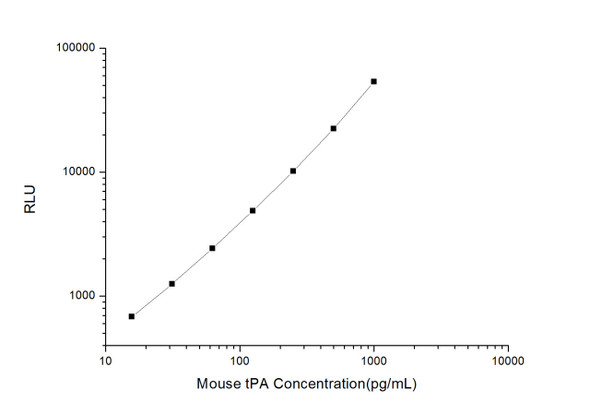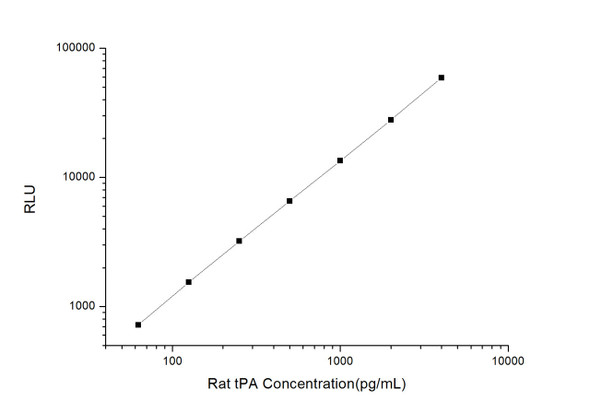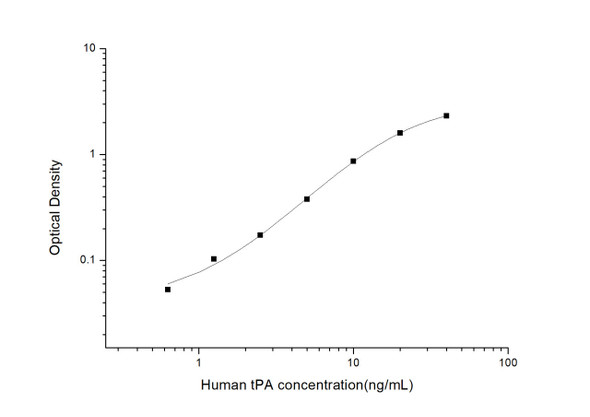Human Cardiovascular ELISA Kits
Human tPA (Plasminogen Activator, Tissue) CLIA Kit (HUES01124)
- SKU:
- HUES01124
- Product Type:
- ELISA Kit
- ELISA Type:
- CLIA Kit
- Size:
- 96 Assays
- Sensitivity:
- 75pg/mL
- Range:
- 125-8000pg/mL
- ELISA Type:
- Sandwich
- Reactivity:
- Human
- Sample Type:
- Serum, plasma and other biological fluids
- Research Area:
- Cardiovascular
Description
| Assay type: | Sandwich |
| Format: | 96T |
| Assay time: | 4.5h |
| Reactivity: | Human |
| Detection method: | Chemiluminescence |
| Detection range: | 125.00-8000 pg/mL |
| Sensitivity: | 75.00 pg/mL |
| Sample volume: | 100µL |
| Sample type: | Serum, plasma and other biological fluids |
| Repeatability: | CV < 15% |
| Specificity: | This kit recognizes Human tPA in samples. No significant cross-reactivity or interference between Human tPA and analogues was observed. |
This kit uses Sandwich-CLIA as the method. The micro CLIA plate provided in this kit has been pre-coated with an antibody specific to Human tPA. Standards or samples are added to the appropriate micro CLIA plate wells and combined with the specific antibody. Then a biotinylated detection antibody specific for Human tPA and Avidin-Horseradish Peroxidase (HRP) conjugate are added to each micro plate well successively and incubated. Free components are washed away. The substrate solution is added to each well. Only those wells that contain Human tPA, biotinylated detection antibody and Avidin-HRP conjugate will appear fluorescence. The Relative light unit (RLU) value is measured spectrophotometrically by the Chemiluminescence immunoassay analyzer. The RLU value is positively associated with the concentration of Human tPA. The concentration of Human tPA in the samples can be calculated by comparing the RLU of the samples to the standard curve.
| UniProt Protein Function: | Converts the abundant, but inactive, zymogen plasminogen to plasmin by hydrolyzing a single Arg-Val bond in plasminogen. By controlling plasmin-mediated proteolysis, it plays an important role in tissue remodeling and degradation, in cell migration and many other physiopathological events. Plays a direct role in facilitating neuronal migration. |
| NCBI Summary: | This gene encodes tissue-type plasminogen activator, a secreted serine protease that converts the proenzyme plasminogen to plasmin, a fibrinolytic enzyme. The encoded preproprotein is proteolytically processed by plasmin or trypsin to generate heavy and light chains. These chains associate via disulfide linkages to form the heterodimeric enzyme. This enzyme plays a role in cell migration and tissue remodeling. Increased enzymatic activity causes hyperfibrinolysis, which manifests as excessive bleeding, while decreased activity leads to hypofibrinolysis, which can result in thrombosis or embolism. Alternative splicing of this gene results in multiple transcript variants, at least one of which encodes an isoform that is proteolytically processed. [provided by RefSeq, Jan 2016] |
| UniProt Code: | P00750 |
| NCBI GenInfo Identifier: | 137119 |
| NCBI Gene ID: | 5327 |
| NCBI Accession: | P00750. 1 |
| UniProt Secondary Accession: | P00750,Q15103, Q503B0, Q6PJA5, Q7Z7N2, Q86YK8, Q9BU99 Q9BZW1, A8K022, B2R8E8, |
| UniProt Related Accession: | P00750 |
| Molecular Weight: | 44,373 Da |
| NCBI Full Name: | Tissue-type plasminogen activator |
| NCBI Synonym Full Names: | plasminogen activator, tissue type |
| NCBI Official Symbol: | PLAT |
| NCBI Official Synonym Symbols: | TPA; T-PA |
| NCBI Protein Information: | tissue-type plasminogen activator |
| UniProt Protein Name: | Tissue-type plasminogen activator |
| UniProt Synonym Protein Names: | INN: Alteplase; INN: Reteplase |
| Protein Family: | Taurine--pyruvate aminotransferase |
| UniProt Gene Name: | PLAT |
As the RLU values of the standard curve may vary according to the conditions of the actual assay performance (e. g. operator, pipetting technique, washing technique or temperature effects), the operator should establish a standard curve for each test. Typical standard curve and data is provided below for reference only.
| Concentration (pg/mL) | RLU | Average | Corrected |
| 8000 | 68122 74756 | 71439 | 71418 |
| 4000 | 34525 36471 | 35498 | 35477 |
| 2000 | 18657 16451 | 17554 | 17533 |
| 1000 | 8025 9151 | 8588 | 8567 |
| 500 | 4153 4061 | 4107 | 4086 |
| 250 | 2009 1725 | 1867 | 1846 |
| 125.00 | 716 778 | 747 | 726 |
| 0 | 20 22 | 21 | -- |
Precision
Intra-assay Precision (Precision within an assay): 3 samples with low, mid range and high level Human tPA were tested 20 times on one plate, respectively.
Inter-assay Precision (Precision between assays): 3 samples with low, mid range and high level Human tPA were tested on 3 different plates, 20 replicates in each plate.
| Intra-assay Precision | Inter-assay Precision | |||||
| Sample | 1 | 2 | 3 | 1 | 2 | 3 |
| n | 20 | 20 | 20 | 20 | 20 | 20 |
| Mean (pg/mL) | 368.54 | 1241.54 | 3545.67 | 345.98 | 1320.62 | 3302.68 |
| Standard deviation | 36.96 | 123.66 | 281.53 | 41.93 | 123.61 | 352.07 |
| C V (%) | 10.03 | 9.96 | 7.94 | 12.12 | 9.36 | 10.66 |
Recovery
The recovery of Human tPA spiked at three different levels in samples throughout the range of the assay was evaluated in various matrices.
| Sample Type | Range (%) | Average Recovery (%) |
| Serum (n=5) | 98-114 | 104 |
| EDTA plasma (n=5) | 92-108 | 100 |
| Cell culture media (n=5) | 94-108 | 100 |
Linearity
Samples were spiked with high concentrations of Human tPA and diluted with Reference Standard & Sample Diluent to produce samples with values within the range of the assay.
| Serum (n=5) | EDTA plasma (n=5) | Cell culture media (n=5) | ||
| 1:2 | Range (%) | 87-100 | 88-100 | 88-101 |
| Average (%) | 94 | 94 | 93 | |
| 1:4 | Range (%) | 101-115 | 91-106 | 86-98 |
| Average (%) | 108 | 98 | 93 | |
| 1:8 | Range (%) | 91-106 | 95-111 | 94-106 |
| Average (%) | 98 | 103 | 100 | |
| 1:16 | Range (%) | 91-104 | 101-118 | 99-115 |
| Average (%) | 96 | 109 | 107 |
An unopened kit can be stored at 4°C for 1 month. If the kit is not used within 1 month, store the items separately according to the following conditions once the kit is received.
| Item | Specifications | Storage |
| Micro CLIA Plate(Dismountable) | 8 wells ×12 strips | -20°C, 6 months |
| Reference Standard | 2 vials | |
| Concentrated Biotinylated Detection Ab (100×) | 1 vial, 120 µL | |
| Concentrated HRP Conjugate (100×) | 1 vial, 120 µL | -20°C(shading light), 6 months |
| Reference Standard & Sample Diluent | 1 vial, 20 mL | 4°C, 6 months |
| Biotinylated Detection Ab Diluent | 1 vial, 14 mL | |
| HRP Conjugate Diluent | 1 vial, 14 mL | |
| Concentrated Wash Buffer (25×) | 1 vial, 30 mL | |
| Substrate Reagent A | 1 vial, 5 mL | 4°C (shading light) |
| Substrate Reagent B | 1 vial, 5 mL | 4°C (shading light) |
| Plate Sealer | 5 pieces | |
| Product Description | 1 copy | |
| Certificate of Analysis | 1 copy |
- Set standard, test sample and control (zero) wells on the pre-coated plate and record theirpositions. It is recommended to measure each standard and sample in duplicate. Note: addall solutions to the bottom of the plate wells while avoiding contact with the well walls. Ensuresolutions do not foam when adding to the wells.
- Aliquot 100 µL of standard solutions into the standard wells.
- Add 100 µL of Sample / Standard dilution buffer into the control (zero) well.
- Add 100 µL of properly diluted sample (serum, plasma, tissue homogenates and otherbiological fluids. ) into test sample wells.
- Cover the plate with the sealer provided in the kit and incubate for 90 min at 37 °C.
- Aspirate the liquid from each well, do not wash. Immediately add 100 µL of BiotinylatedDetection Ab working solution to each well. Cover the plate with a plate seal and gently mix. Incubate for 1 hour at 37 °C.
- Aspirate or decant the solution from the plate and add 350 µL of wash buffer to each welland incubate for 1-2 minutes at room temperature. Aspirate the solution from each well andclap the plate on absorbent filter paper to dry. Repeat this process 3 times. Note: a microplatewasher can be used in this step and other wash steps.
- Add 100 µL of HRP Conjugate working solution to each well. Cover with a plate seal andincubate for 30 min at 37 °C.
- Aspirate or decant the solution from each well. Repeat the wash process for five times asconducted in step 7.
- Add 100 µL of Substrate mixture solution to each well. Cover with a new plate seal andincubate for no more than 5 min at 37 °C. Protect the plate from light.
- Determine the RLU value of each well immediately.






